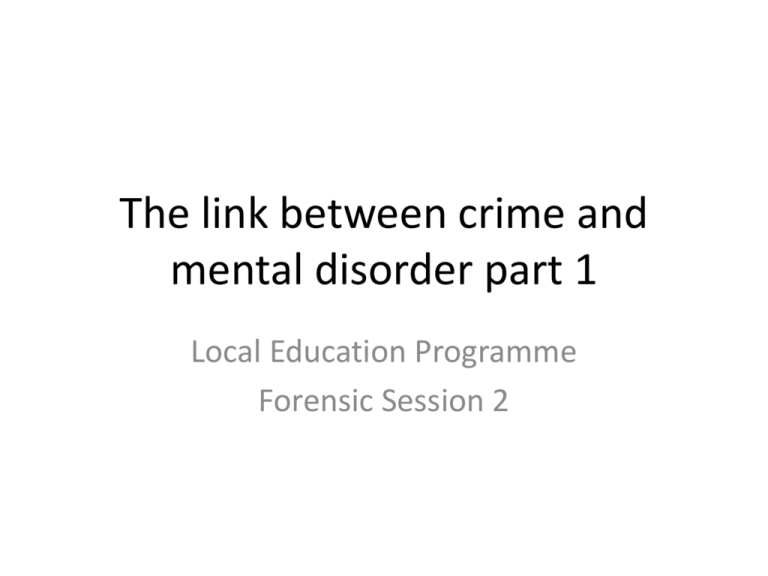
The link between crime and
mental disorder part 1
Local Education Programme
Forensic Session 2
Outline of the day
1–2
2–3
3 – 3.15
3.15 – 3.30
3.30 – 4.30
4.30 – 5
Case Presentation
Journal Club Presentation
Break
555
‘The link between crime and
mental disorder – part 1’
MCQs & reflection
Curriculum Links
12.1
Relationship between crime and mental disorder
12.1.1
Knowledge of the range of offences committed by mentallydisordered offenders. Specific crimes and their psychiatric relevance
particularly: homicide; other crimes of violence (including
infanticide); sex offences; arson; and criminal damage
12.1.2
The relationship between specific mental disorders and crime:
substance misuse; epilepsy; schizophrenia; bipolar affective
disorder; neuro-developmental disorders; and personality disorders
12.1.4
Mental disorders and offending in special groups: young offenders;
female offenders; offenders from ethnic minorities; and offenders
who are deaf or have other physical disabilities
Learning Objectives
To develop an understanding of…
• The types of offences committed by mentallydisordered offenders
• The aetiology of certain crimes including violent
offences, sex offences, criminal damage and firesetting
• The ranges of offences committed by offenders
with schizophrenia, affective disorder and
personality disorder
• Genetic and gender-specific factors in offending
The link between crime and
mental disorder part 1
The offences
SEX OFFENDING
Sexual Offence
“A criminal offence involving sexual behaviour
occurs when one party does not give, or is
incapable of giving fully informed consent or
where the difference in power between two
parties is such that one is not in a position to
make a truly free choice.”
O’Connell 1990
Sex Offending
Serious
sexual
offences
• Rape
• Sexual assault
• Sexual activity with children
Other
sexual
offences
• Soliciting
• Exploitation of prostitution
• Unlawful sexual activity between 2
consenting adults
Offence
Description
Maximum
Sentence
Rape
Penetration of vagina, anus or mouth by penis where
the victim at the time does not consent, and the
perpetrator knows they do no consent or is reckless as
to whether they consent. An offence of basic intent
Life imprisonment
Assault by
penetration
Intentional penetration of vagina or anus with a part
of body or anything else, without consent
Life imprisonment
Sexual assault
Intentional sexual touching of another person without
consent. Covers a wide range of behaviours and
circumstances. Accordingly it is triable either way
10 years
imprisonment
Causing sexual
activity without
consent
Intentionally causing another to act in a sexual way
without consent, for example forced masturbation, a
woman facing a man to penetrate her or forcing sexual
activity with a third party
Life imprisonment if
penetration
involved, otherwise
10 years
Frequency of sexual offending
• 11% victims of serious sexual assault report the
incident to the police (Povey et al 2009)
• Under-reporting due to
– Shame and fear
– Victim known to offender
• Study by Feist et al 2007 of 676 alleged rapes
– 8% false allegation
– 70% not charged
– 13% convicted (not necessarily for rape)
• 6% rape allegations lead to a conviction for rape
Types of sex offender
• 3% sexual offenders are female
• Compared with matched population controls,
sex offenders have odds ratios of
– 6.3 for psychiatric admission
– 4.8 for schizophrenia
– 5.2 for affective psychoses
– 3.4 for bipolar affective disorder.
Assessment of sex offenders
• Four domains of psychological problem to
consider
– Sexual interests
– Distorted attitudes
– Problems with socio-affective management
– Problems with self-management
Risk assessment tools
•
•
•
•
Static-2002
Risk Matrix 2000
Sex Offender Risk Appraisal Guide (SORAG)
Rapid Risk Assessment for Sex Offender
Recidivism (RRASOR)
• Risk of Sexual Violence Protocol (RSVP)
Psychological treatment
• Aim to reduce risk by identifying and
modifying dynamic risk factors
• Sex Offender Treatment Programme (SOTP)
– Standardised
– Usually group
– Adapted programme for low IQ
– Efficacy – evidence conflicting
• 4 semi-structured interviews
• Assessment of psychopathy (PCL-R) and psychometric testing
Assessment • Some have PPG
• Essential for all – increase sense of responsibility for offence and victim-empathy
• Increases motivation and skills to avoid re-offending
• Supplemented by thinking skills programme to improve decision-making skills and coping
Core
Programme strategies
• Shorter, related treatment programmes
• Anger and stress management
Extended • Relationship skills
programme • Behavioural therapy (to address fantasies) – done on an individual basis
Booster
programme
• During the year before release
• Revision of the core programme
• Produce strategies for relapse prevention
Pharmacological Treatment
• As part of a comprehensive treatment
package
• 3 classes
– SSRIs
– Antiandrogens
– Luteinizing hormone-releasing hormone agonists
Reconviction rates
• Hood et al (2002) followed up 192 sex
offenders for 4 – 6 years following release
from prison
– 8.5% convicted for sexual offence
– 18.1% imprisoned for any offence
– Reconviction rates lower
• Those who had offended against a child in own family
• Those who had offended against adults
STALKING
Stalking
• Repeated intrusions involving unwanted
contacts and / or communication
• 15% women lifetime prevalence
• Individual formulation required
• Mullen et al (2006) devised a typology of
stalkers
Rejected
Angry, dependent man pursuing an ex-partner. Unable
to accept rejection. Stalking maintains a semblance of a
relationship
Intimacy
seekers
Socially incompetent fantasist seeking a relationship
with someone with whom they are in love, or they
believed to be in love with them. Includes delusional
erotomania.
Incompetent Pursue intimate relationships inappropriately due to
suitor
poor social skills and/or a sense of entitlement. May
occur in LD or ASD. May be easy to persuade them to
stop stalking one victim, but the behaviour may recur
with someone else.
Resentful
Motivated by revenge for some slight / insult, so well
aware of distress or fear of victim. Likely to threaten,
but less likely to carry out violence. Paranoid PD
common.
Predatory
Stalking is preparatory to a sexual assault
FIRE-SETTING
Frequency of arson offences in
England and Wales
Fire-setting and mental disorder
Diagnosis
Personality disorder
Learning disability
Psychosis
Alcohol misuse
Depressive disorder
Substance misuse
Conduct disorder
Not known
No diagnosis
Percentage
54
11
8
8
5
3
1
1
13
Motivation for fire-setting
Criminal motivation
• Financial compensation
• Hide / destroy evidence
• Political
• Wider pattern of antisocial behaviour
• Emotional – jealousy, anger, revenge
Psychopathological
motivation
• To commit suicide
• Psychosis
• To communicate distress / seek support
• Boost self-esteem (i.e. to be the hero)
• Pyromania
Psychiatric Assessment
• Specific focus on history of
– Childhood fireplay
– Previous acts of fire-setting (including undetected)
– Previous threats or targets
– Types of fire set
• Use of accelerants
• Multiple seats
– Motivation for previous acts
Psychiatric Assessment
• Functional assessment of index incident
– Recent psychosocial stressors
– Affect and circumstances of fire
– Intoxication / disinhibiting factors
– Acts of planning and preparation
– Fascination / preoccupation with fire and
associated items
– Feelings immediately before and after the act
Pathological fire-setting
• ‘Habit and impulse disorder’ (ICD-10)
• Interest in fire and associated things
– Likely to watch fire, call fire brigade and watch intervention
• Compulsive nature – anticipatory subjective tension
followed by excitement
• More common in
– Males
– LD
– Inadequate personality
Treatment
Very few modifiable risk factors to address
Educational vs psychological approach
Educational
Psychological
• Typically with children
• Information on fire safety skills
• Information on risks and consequences
• CBT-based group interventions in hospital settings
• (little available in prison or probation settings)
Psychological Programmes
Fire Setter Treatment
Programme (FSTP)
High secure treatment
programmes
• Designed for LD patients
• 40 sessions
• Offence-focus
• Education, skills and
development of anger
management and selfesteem
• Relapse prevention
• 62 sessions
• Education
• Skills developing – social
skills, problem solving
and conflict resolution
• Insight and selfawareness
• Relapse prevention
Reoffending
• Rates vary from 4 – 60%
• Risk factors for recidivism
– Young age
– Single
– Developmental history of family violence or substance
misuse
– Early onset of criminal convictions
– Lengthier prison stays
– Relationship problems
– More previous convictions for property offences
Dickens et al (2007)
VIOLENCE, HOMICIDE &
INFANTICIDE
Serious Mental Illness (SMI) & violence
/ homicide
• PAR – violence in population due to
schizophrenia
– 2 – 10%s
• Rates of homicide due to SMI – studies have
shown…..
– Nearly 40% homicides committed before
treatment
– 1 in 629 psychotic patients commits homicide
before treatment
– 1 in 9090 psychotic patients commit homicide
each year after receiving treatment Nielssen and Large
(2010)
SMI & homicide
• Shaw et al (2006) surveyed 1594 homicides
over 3 years
– 34% lifetime mental disorder
•
•
•
•
•
5 – 7% schizophrenia
7 – 10% affective disorder
9 – 11% personality disorder
7 – 10% alcohol dependence
6 – 8% drug dependence
– 5 – 6% psychotic and 6 – 9% depressed at time of
offence
Schizophrenia & homicide
•
•
•
•
•
•
72% known to MH services
Single (78%)
Unemployed (68%)
H/o alcohol misuse (37%)
H/o drug misuse (51%)
H/o violent convictions (32%)
• More likely to use sharp instrument /
strangulation
FEP and homicide
• Annual rate of homicide before treatment is
15 times higher than rate after treatment
• Could earlier treatment prevent some
homicides?
• Countries where DUP is lower – fewer
homicides in FEP
• Improved psychiatric care in England & Wales
fall in homicide rate by people with SMI
Homicide perpetrators
Schizophrenia
Affective disorder
Method
More likely to use a
sharp instrument
More likely to use
strangulation ,
suffocation,
asphyxiation or
drowning
Symptomatic at time of
offence
81%
75%
Relationship of victim
22% spouse / ex-spouse
23% family member
23% acquaintance
9% stranger
52% spouse / ex-spouse
16% son / daughter
Rodway et al 2009
Violence and schizophrenia
• Increased rate of violence with MD, and SZ in
particular
• Size of increase is modest and contribution of
SZ to societal violence is small
• Very large part of the increased risk is due to
substance use, which is more common in
those with MD and SZ
Stranger Homicide
• 9% all homicides committed by psychotic
offenders were stranger homicides
– Equates to 1 in 14.3 million people per year
• Stranger homicides
– More likely to be in a public place
– Offenders have fewer negative symptoms
– Larger proportion have had no previous treatment
and longer period of DUP
– Delusional beliefs about victim
Filicide, Infanticide & Neonaticide
• Fillicide = killing of a child by his / her parent
• Infanticide = killing of a child before age of 12
months
• Neonaticide = killing of a child within 24 hours
of birth
Incidence of filicide
• Average 32 cases filicide per year
– 50% all child homicides
• Children under 1 greatest risk (55%)
• Male (67%) vs Female (33%) perpetrator
• Associated with suicide
– 16 – 29% maternal filicides
– 40 – 60 % paternal filicides
• 38% affective disorder
• 16% personality disorder
• 13% schizophrenia
Maternal Filicides
• Women who kill their children….
– 20 – 40 years
– No association with marital status
• Neonaticide more likely single
– Poverty
– 20% minority ethnic group
– Depression
Motivation for filicide
•
•
•
•
•
Altruistic / mercy killing
Unwanted children
Accidental
Retaliation or spousal revenge
Mental illness
References
•
Department of Health (2001) Safety first: five year report of the National
Confidential Inquiry into Suicide and homicide by people with mental illness.
London: DH
•
Dickens G, Sugarman P, Ahmad F et al (2007) Gender differences among adult
arsonists at psychiatric assessment. Medicine Science & Law 47, 233 – 8
•
Eldridge HJ (2000) Patterns of offending and strategies for effective assessment
and intervention. In: Itzin C (ed) Home truths about child sexual abuse. London:
Routledge
•
Fazel S, Sjostedt G, Langstrom N et al (2007) Severe mental illness and risk of
sexual offending in men: a case-control study based on Swedish national registers.
J Clin Psych 68(4), 588 - 96
•
Friedman SH, Hrouda DR, Holden CE et al (2005) Filicide-suicide: common factors
in parents who kill their children and themselves. J Am Acad Psych Law 33: 496 504
•
Friendship C, Mann R & Beech A (2003) The prison-base Sex Offender Treatment
Programme- an evaluation. London: Home Office
•
Glancy GD, Spiers EM, Pitt SE et al (2003) Commentary: models and correlates of
firesetting behaviour. Journal of the American Academy of Law and Psychiatry 31,
53 – 7
•
Hood R, Shute S, Feilzer M et al (2002) Reconviction rates of serious sex offenders
and assessments of their risk. Home Office.
•
Mullen P, Pathe M & Purcell P (2001) The management of stalkers. APT 7: 335 - 42
•
National Confidential Inquiry (2009) Filicide: A literature review. National
Confidential Inquiry into Suicide and Homicide by people with mental illness
•
Nielssen O, Bourget D, Laajasalo T et al (2011) Homicide of strangers by people
with a psychotic illness. Schizophrenia Bulletin 37(3): 572 - 579
•
Nielssen O. & Large M. (2010) Rates of homicide during the first episode of
psychosis and after treatment: a systematic review and meta-analysis.
Schizophrenia Bulletin 36(4): 702 – 712
• O’Connell MA, Leberg E & Donaldson CR (1990) Working with sex
offenders: guidelines for therapist selection. Newbury Park: Sage
Publications
• Povey D, Coleman K, Kaiza P et al (2009) Homicides, firearm offences and
intimate violence 2007 / 08 (Supplementary volume 2 to Crime in England
and Wales 2007/08) Home Office Statistical Bulletin 02/09. London: Home
Office.
• Rix K (1994) A psychiatric study of adult arsonists. Medicine Science & Law
4(1), 21 - 34
• Rodway C, Flynn S, Swinson N et al (2009) Methods of homicide in England
and Wales: a comparison by diagnostic group. J Forensic Psych and Psychol
20(2), 286 – 305
• Shaw J, Amos T, Hunt IM et al (2006) Rates of mental disorder in people
convicted of homicide. BJPsych 188: 143 – 7
• Thornton D (2002) Constructing and testing a framework for dynamic risk
assessment. Sexual Abuse: a journal of research and treatment 14, 139 –
53







